HONDA ODYSSEY 2006 RB1-RB2 / 3.G Owners Manual
Manufacturer: HONDA, Model Year: 2006, Model line: ODYSSEY, Model: HONDA ODYSSEY 2006 RB1-RB2 / 3.GPages: 420, PDF Size: 6.01 MB
Page 361 of 420
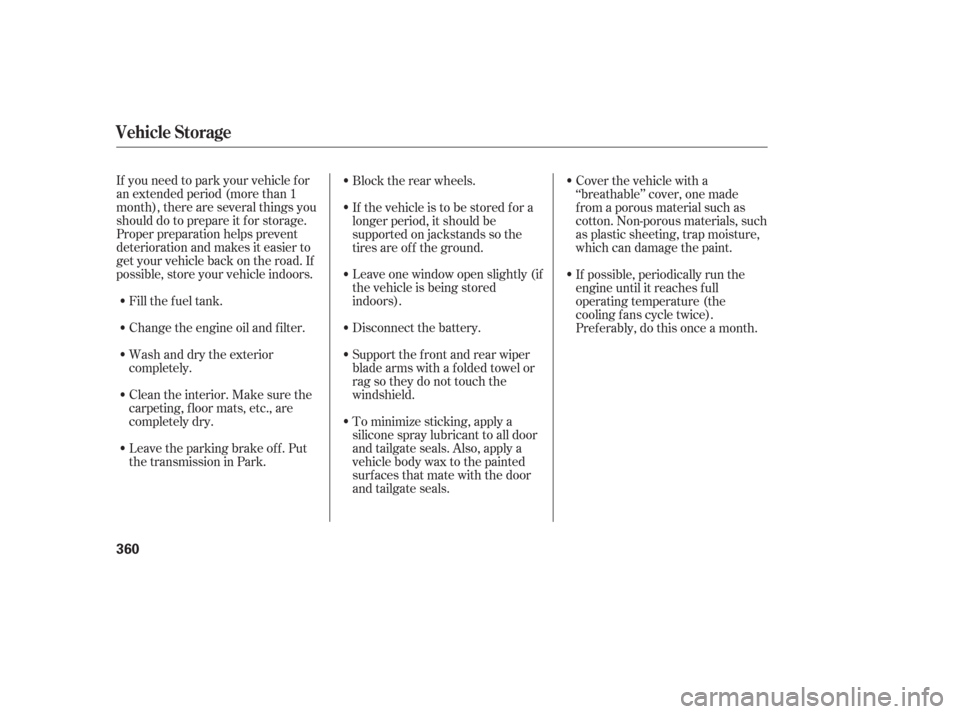
If you need to park your vehicle f or
an extended period (more than 1
month), there are several things you
should do to prepare it f or storage.
Proper preparation helps prevent
deterioration and makes it easier to
get your vehicle back on the road. If
possible, store your vehicle indoors.Fill the f uel tank.
Change the engine oil and f ilter.
Wash and dry the exterior
completely.
Cleantheinterior.Makesurethe
carpeting, floor mats, etc., are
completely dry.
Leave the parking brake off. Put
the transmission in Park. Block the rear wheels.
If the vehicle is to be stored f or a
longer period, it should be
supported on jackstands so the
tires are of f the ground.
Leave one window open slightly (if
the vehicle is being stored
indoors).
Disconnect the battery.
Support the f ront and rear wiper
blade arms with a f olded towel or
ragsotheydonottouchthe
windshield.
To minimize sticking, apply a
silicone spray lubricant to all door
and tailgate seals. Also, apply a
vehiclebodywaxtothepainted
surfaces that mate with the door
and tailgate seals.Cover the vehicle with a
‘‘breathable’’ cover, one made
f rom a porous material such as
cotton. Non-porous materials, such
as plastic sheeting, trap moisture,
which can damage the paint.
If possible, periodically run the
engine until it reaches f ull
operating temperature (the
cooling f ans cycle twice).
Pref erably, do this once a month.
Vehicle Storage
360
Page 362 of 420
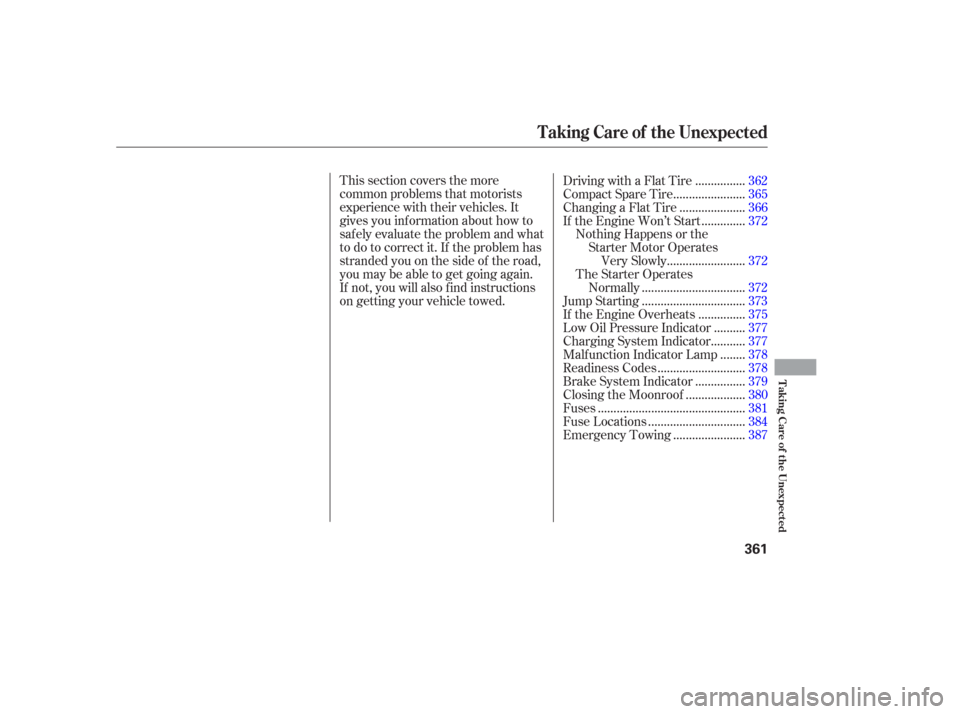
This section covers the more
common problems that motorists
experience with their vehicles. It
gives you inf ormation about how to
safely evaluate the problem and what
to do to correct it. If the problem has
stranded you on the side of the road,
you may be able to get going again.
If not, you will also f ind instructions
on getting your vehicle towed................
Driving with a Flat Tire .362
......................
Compact Spare Tire .365
....................
Changing a Flat Tire .366
.............
If the Engine Won’t Start .372
Nothing Happens or theStarter Motor Operates ........................
Very Slowly .372
The Starter Operates ................................
Normally .372
................................
Jump Starting .373
..............
If the Engine Overheats .375
.........
Low Oil Pressure Indicator .377
..........
Charging System Indicator .377
.......
Malf unction Indicator Lamp .378
...........................
Readiness Codes .378
...............
Brake System Indicator .379
..................
Closing the Moonroof .380
..............................................
Fuses .381
..............................
Fuse Locations .384
......................
Emergency Towing .387
Taking Care of the Unexpected
T aking Care of t he Unexpect ed
361
Page 363 of 420
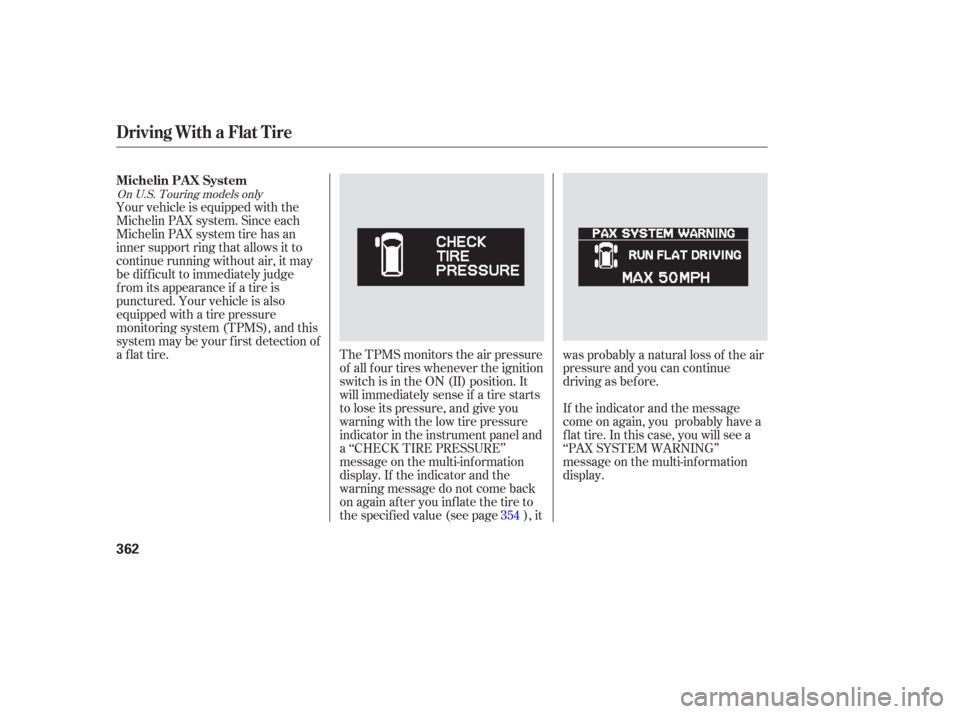
Your vehicle is equipped with the
Michelin PAX system. Since each
Michelin PAX system tire has an
inner support ring that allows it to
continue running without air, it may
be dif f icult to immediately judge
f rom its appearance if a tire is
punctured. Your vehicle is also
equipped with a tire pressure
monitoring system (TPMS), and this
system may be your f irst detection of
a f lat tire.The TPMS monitors the air pressure
of all f our tires whenever the ignition
switch is in the ON (II) position. It
will immediately sense if a tire starts
to lose its pressure, and give you
warning with the low tire pressure
indicator in the instrument panel and
a ‘‘CHECK TIRE PRESSURE’’
message on the multi-inf ormation
display. If the indicator and the
warning message do not come back
on again af ter you inf late the tire to
the specif ied value (see page ), it was probably a natural loss of the air
pressure and you can continue
driving as bef ore.
If the indicator and the message
come on again, you probably have a
flat tire. In this case, you will see a
‘‘PAX SYSTEM WARNING’’
message on the multi-information
display.
354
On U.S. Touring models only
Driving With a Flat Tire
Michelin PA X System
362
Page 364 of 420
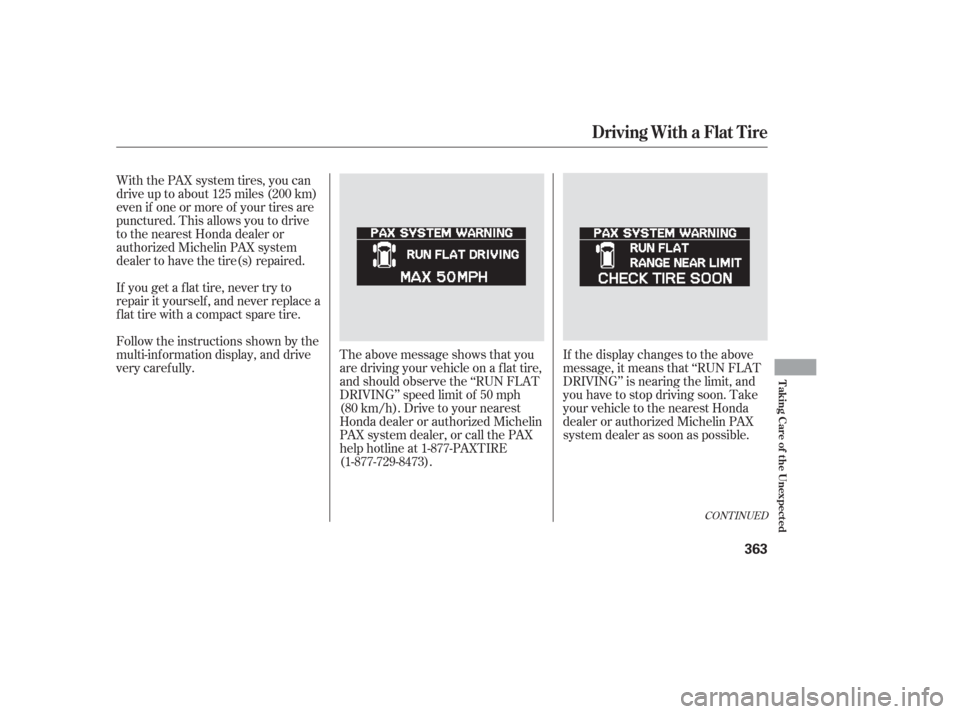
With the PAX system tires, you can
drive up to about 125 miles (200 km)
even if one or more of your tires are
punctured. This allows you to drive
to the nearest Honda dealer or
authorized Michelin PAX system
dealer to have the tire(s) repaired.
If you get a f lat tire, never try to
repair it yourself , and never replace a
flat tire with a compact spare tire.The above message shows that you
are driving your vehicle on a flat tire,
andshouldobservethe‘‘RUNFLAT
DRIVING’’ speed limit of 50 mph
(80 km/h). Drive to your nearest
Honda dealer or authorized Michelin
PAX system dealer, or call the PAX
help hotline at 1-877-PAXTIRE
(1-877-729-8473).If the display changes to the above
message, it means that ‘‘RUN FLAT
DRIVING’’ is nearing the limit, and
you have to stop driving soon. Take
your vehicle to the nearest Honda
dealer or authorized Michelin PAX
system dealer as soon as possible.
Follow the instructions shown by the
multi-inf ormation display, and drive
very caref ully.
CONT INUED
Driving With a Flat Tire
T aking Care of t he Unexpect ed
363
Page 365 of 420
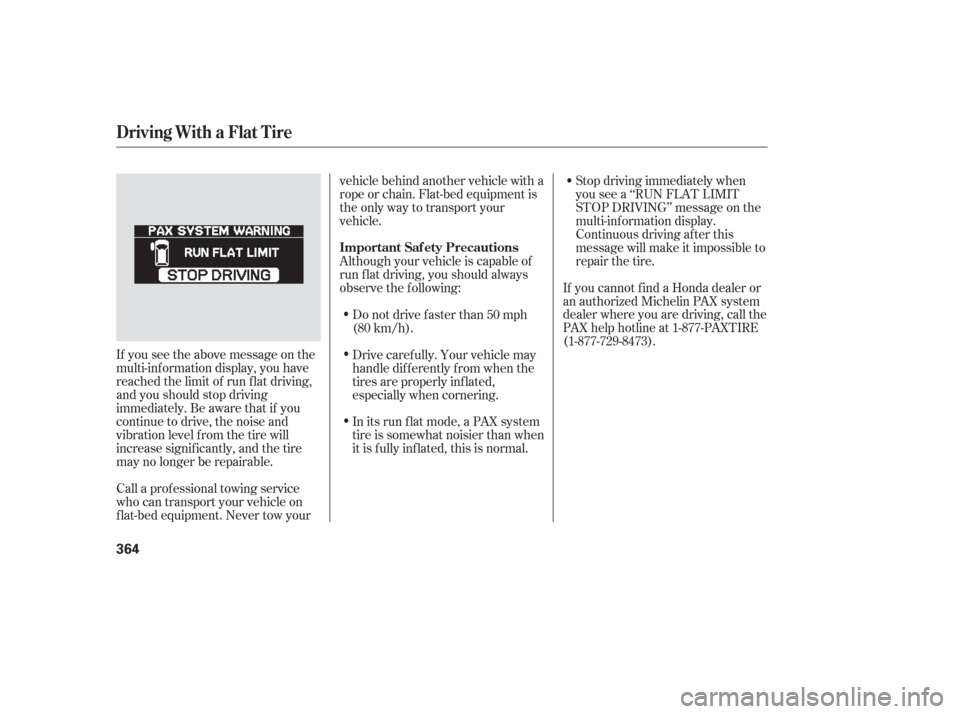
If you see the above message on the
multi-inf ormation display, you have
reached the limit of run f lat driving,
and you should stop driving
immediately. Be aware that if you
continue to drive, the noise and
vibration level f rom the tire will
increase signif icantly, and the tire
may no longer be repairable.Stop driving immediately when
you see a ‘‘RUN FLAT LIMIT
STOP DRIVING’’ message on the
multi-inf ormation display.
Continuous driving af ter this
message will make it impossible to
repair the tire.
If you cannot f ind a Honda dealer or
an authorized Michelin PAX system
dealer where you are driving, call the
PAX help hotline at 1-877-PAXTIRE
(1-877-729-8473).
Call a prof essional towing service
who can transport your vehicle on
f lat-bed equipment. Never tow your vehicle behind another vehicle with a
rope or chain. Flat-bed equipment is
the only way to transport your
vehicle.
Do not drive f aster than 50 mph
(80 km/h).
Drive caref ully. Your vehicle may
handle dif f erently f rom when the
tires are properly inf lated,
especially when cornering.
In its run f lat mode, a PAX system
tire is somewhat noisier than when
it is f ully inf lated, this is normal.
Although your vehicle is capable of
runflatdriving,youshouldalways
observe the f ollowing:
Driving With a Flat Tire
Important Saf ety Precautions
364
Page 366 of 420
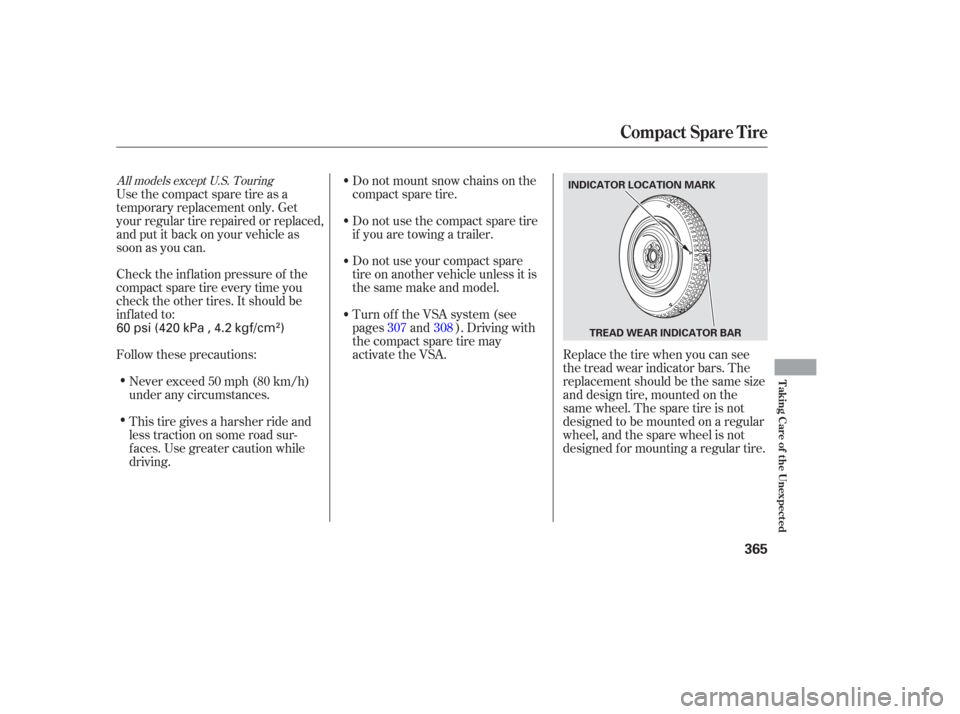
Replace the tire when you can see
the tread wear indicator bars. The
replacement should be the same size
and design tire, mounted on the
same wheel. The spare tire is not
designed to be mounted on a regular
wheel, and the spare wheel is not
designed f or mounting a regular tire.
Do not mount snow chains on the
compact spare tire.
Turn of f the VSA system (see
pages and ). Driving with
thecompactsparetiremay
activate the VSA. Do not use your compact spare
tire on another vehicle unless it is
thesamemakeandmodel. Do not use the compact spare tire
if you are towing a trailer.
This tire gives a harsher ride and
less traction on some road sur-
f aces. Use greater caution while
driving. Never exceed 50 mph (80 km/h)
under any circumstances.
Follow these precautions: Check the inf lation pressure of the
compact spare tire every time you
check the other tires. It should be
inf lated to: Use the compact spare tire as a
temporary replacement only. Get
your regular tire repaired or replaced,
and put it back on your vehicle as
soon as you can.
307 308
All models except U.S. Touring
Compact Spare T ire
T aking Care of t he Unexpect ed
365
INDICATOR LOCATION MARK
TREAD WEAR INDICATOR BAR
60 psi (420 kPa , 4.2 kgf/cm)
Page 367 of 420
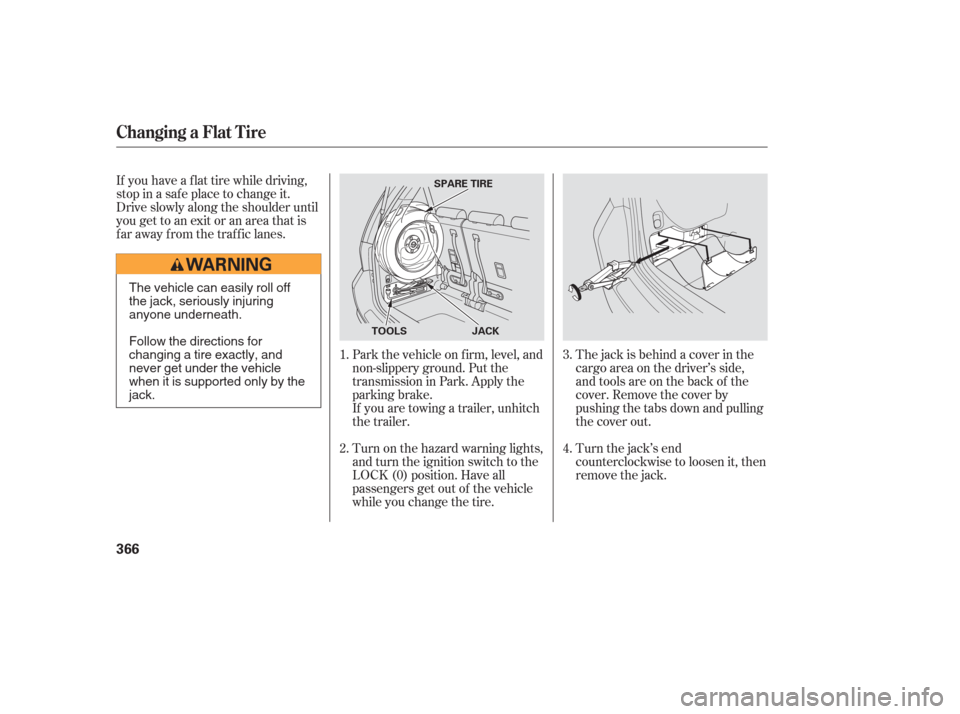
If you have a f lat tire while driving,
stop in a saf e place to change it.
Drive slowly along the shoulder until
you get to an exit or an area that is
far away from the traffic lanes.The jack is behind a cover in the
cargo area on the driver’s side,
and tools are on the back of the
cover. Remove the cover by
pushing the tabs down and pulling
the cover out.
Turn the jack’s end
counterclockwise to loosen it, then
remove the jack.
Park the vehicle on f irm, level, and
non-slippery ground. Put the
transmission in Park. Apply the
parking brake.
If you are towing a trailer, unhitch
the trailer.
Turn on the hazard warning lights,
and turn the ignition switch to the
LOCK (0) position. Have all
passengers get out of the vehicle
while you change the tire.
2. 1.
3.
4.
Changing a Flat Tire
366
JACK
SPARE TIRE
TOOLS
The vehicle can easily roll off
the jack, seriously injuring
anyone underneath.
Follow the directions for
changing a tire exactly, and
never get under the vehicle
when it is supported only by the
jack.
Page 368 of 420
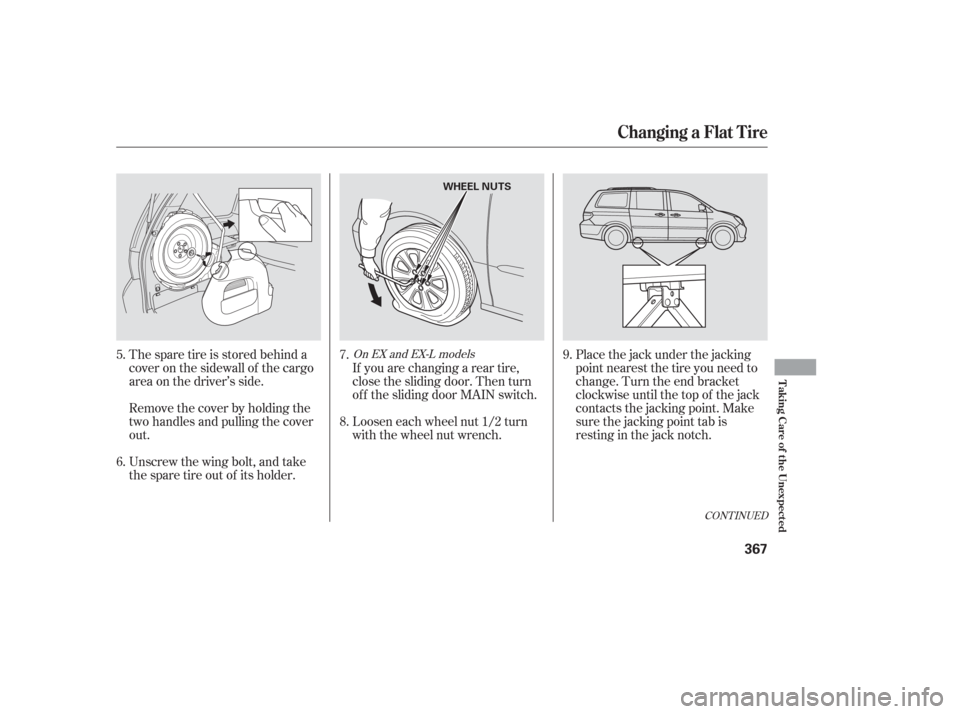
The spare tire is stored behind a
cover on the sidewall of the cargo
area on the driver’s side.
Remove the cover by holding the
two handles and pulling the cover
out.
Unscrew the wing bolt, and take
the spare tire out of its holder.If you are changing a rear tire,
close the sliding door. Then turn
of f the sliding door MAIN switch.
Loosen each wheel nut 1/2 turn
with the wheel nut wrench.
Placethejackunderthejacking
point nearest the tire you need to
change. Turn the end bracket
clockwise until the top of the jack
contacts the jacking point. Make
sure the jacking point tab is
restinginthejacknotch.
5.
6. 7.
8.
9.
CONT INUED
On EX and EX-L models
Changing a Flat Tire
T aking Care of t he Unexpect ed
367
WHEEL NUTS
Page 369 of 420
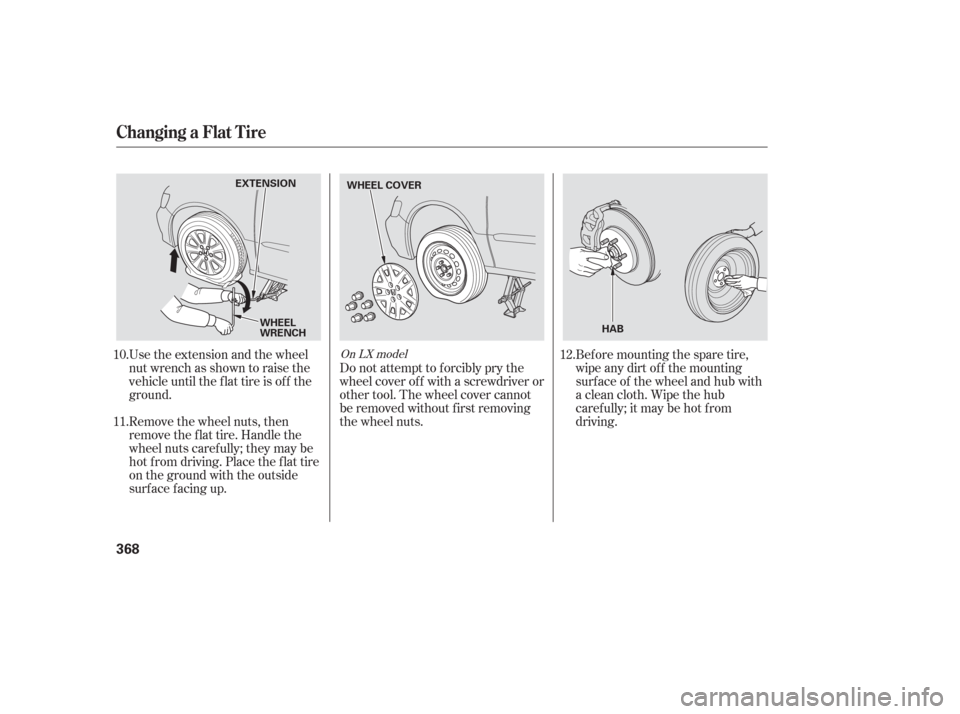
Use the extension and the wheel
nut wrench as shown to raise the
vehicle until the f lat tire is of f the
ground.
Remove the wheel nuts, then
remove the f lat tire. Handle the
wheel nuts caref ully; they may be
hot from driving. Place the flat tire
on the ground with the outside
surface facing up.Do not attempt to forcibly pry the
wheel cover of f with a screwdriver or
other tool. The wheel cover cannot
be removed without f irst removing
the wheel nuts.
Bef ore mounting the spare tire,
wipe any dirt of f the mounting
surface of the wheel and hub with
a clean cloth. Wipe the hub
carefully;itmaybehotfrom
driving.
11. 10. 12.On LX model
Changing a Flat Tire
368
WHEEL
WRENCH
EXTENSION
WHEEL COVER
HAB
Page 370 of 420
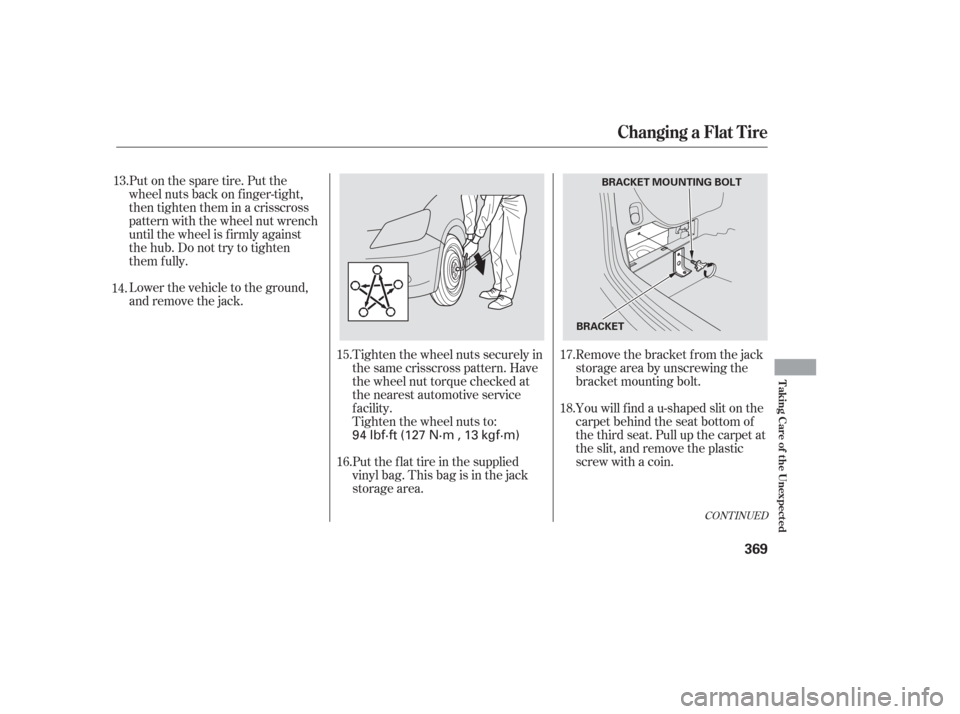
Tighten the wheel nuts securely in
the same crisscross pattern. Have
the wheel nut torque checked at
the nearest automotive service
f acility.
Tighten the wheel nuts to:Remove the bracket from the jack
storageareabyunscrewingthe
bracket mounting bolt.
Put the f lat tire in the supplied
vinyl bag. This bag is in the jack
storage area. You will f ind a u-shaped slit on the
carpet behind the seat bottom of
the third seat. Pull up the carpet at
the slit, and remove the plastic
screw with a coin.
Lower the vehicle to the ground,
and remove the jack. Put on the spare tire. Put the
wheel nuts back on f inger-tight,
then tighten them in a crisscross
pattern with the wheel nut wrench
until the wheel is f irmly against
the hub. Do not try to tighten
them f ully.
13.
14. 15.17.
18.
16.
CONT INUED
Changing a Flat Tire
T aking Care of t he Unexpect ed
369
BRACKET BRACKET MOUNTING BOLT
94 lbf·ft (127 N·m , 13 kgf·m)